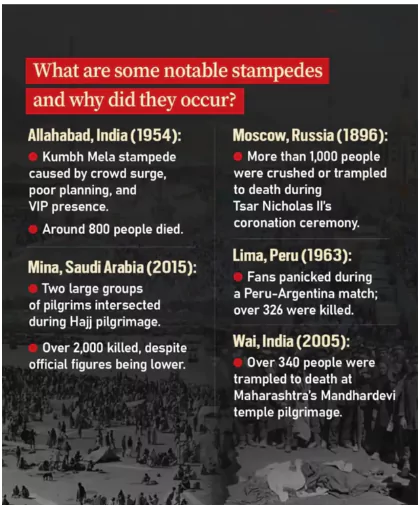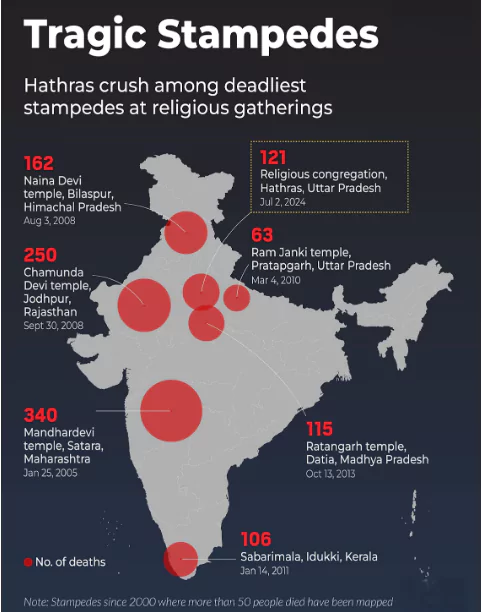Recently, 18 people were killed in a stampede at the New Delhi Railway Station which happened following a surge in the crowd of passengers waiting to board trains for Prayagraj.
What is a Stampede?
- A stampede is an impulsive mass movement of a crowd, often resulting in injuries and deaths. It occurs due to a perceived danger or loss of physical space, leading to irrational and dangerous movements for self-protection.
- Status of Stampede in India: According to the National Crime Records Bureau figures, from 2000 to 2013, almost 2,000 people died in stampedes.
- A 2013 study published by International Journal of Disaster Risk Reduction (IJDRR) points out that religious gatherings and pilgrimages have been venues for 79% of the stampedes in India.
- Types of Stampedes
- Unidirectional stampede: Occur when a crowd moving in the same direction encounters a sudden positive or negative change in force which alters its movement.
- A positive force can be a “sudden stop” situation like a bottleneck and blocked exit.
- A negative force would be something like a broken barrier or column which sends a group of people tumbling.
- Turbulent Stampede: Happens when crowds merge from different directions, often due to panic or uncontrolled movement
Psychology of Stampedes
- The ‘Craze’ Behaviour: Craze is defined by sociologist Neil J Smelser In Theory of Collective Behavior (1962), as “the mobilisation for action based on a positive wish-fulfillment belief” which can be rational or irrational.
- The Black Hole Phenomenon: The phenomenon is being described by Helbing in a 2014 paper in the Journal of Statistical Physics.
- Force Chains: As per it, the contact between people’s bodies in a tightly packed environment causes physical forces to be transmitted from one individual to another which may add up and create unpredictable “force chains” pushing the individuals from various directions.
- Black Hole: Eventually, the pushes may reach to a level that can cause one or more individuals to stumble and fall, creating a “hole” in the crowd breaking the balance of forces. The surrounding crowd is still being pushed from behind, but no longer from the front because of the “hole” leading to more stumbling and falling.
|
Factors Leading to Stampedes
- Human Psychology and Panic: Panic spreads rapidly in large crowds, triggering irrational movements. Once cooperative behavior breaks down, individuals focus on self-preservation, worsening the situation.
- Hathras Stampede (2024): Devotees rushed to touch a preacher’s feet, leading to uncontrolled movement and 121 deaths.
- Structural Deficiencies & Poor Infrastructure: Narrow pathways, weak barriers, and poorly designed exits restrict movement and create bottlenecks.
- Ratangarh Temple Stampede (2013): A railing collapse on a bridge led to mass panic, causing 121 deaths and injuries to over 100 people.
- High Crowd Density: When crowd density exceeds 4 persons per sq. meter, movement becomes difficult, increasing stampede risks.
- Vaishno Devi Temple (2022): 12 devotees died when a sudden surge of pilgrims entering the shrine caused suffocation and crushing.
- Poor Crowd Management & Lack of Coordination: Unclear responsibilities among security personnel, event organizers, and local authorities lead to mismanagement during emergencies.
 Maha Kumbh Mela Stampede (2025): Authorities failed to anticipate the crowd size, leading to a rush at Sangam Ghat in Prayagraj, causing 30 deaths and 60 injuries.
Maha Kumbh Mela Stampede (2025): Authorities failed to anticipate the crowd size, leading to a rush at Sangam Ghat in Prayagraj, causing 30 deaths and 60 injuries.- According to the National Disaster Management Authority (NDMA), poor planning and lack of coordination among multiple agencies are key reasons for recurring crowd disasters in India.
- Rumors and Misinformation: False alarms, such as rumors of bomb threats or collapsing structures, cause sudden panic.
- Chamunda Devi Temple (2008): A false rumor of a bomb led to mass panic, resulting in more than 220 deaths as people trampled over each other.
- Inadequate Emergency Exits & Escape Routes: Lack of properly planned exits leads to crushing and suffocation in confined spaces.
- Uphaar Cinema Fire (1997, Delhi): Emergency exits were locked, preventing escape, leading to 59 deaths from smoke inhalation.
- Sudden Surges Due to Religious or Cultural Fervor: Mass religious gatherings often lead to unpredictable crowd surges, making them difficult to control.
- Sabarimala Temple (2011): A surge in pilgrims moving down a narrow path caused more than 100 deaths due to lack of crowd regulation.
Causes of Stampede Casualties
- Traumatic Asphyxia (Crushing & Suffocation): When people are tightly packed, intense pressure on the chest prevents breathing, leading to suffocation.
- Compressive asphyxia (external compression on the thorax and abdomen) is the most common cause of death in stampedes (NDMA Report, 2014).
 Myocardial Infarction (Heart Attacks Due to Stress & Panic): The extreme stress and exertion during a stampede can trigger heart attacks, especially in the elderly.
Myocardial Infarction (Heart Attacks Due to Stress & Panic): The extreme stress and exertion during a stampede can trigger heart attacks, especially in the elderly.-
- A study on crowd disasters by Chun-Hao Shao (2018) found that people trapped in stampedes often suffer cardiac arrests due to oxygen deprivation and high stress levels.
- Head and Neck Injuries (Falling & Being Trampled): When individuals lose their balance, they are often trampled by others, leading to fatal head, spinal, and internal injuries.
- Chamunda Devi Temple (2008) – The chaotic rush led to 250 deaths, with most victims suffering head and neck trauma from being trampled.
- Lacerations and Fractures (Blunt Force Trauma): The force exerted by moving crowds can break bones, cause severe bruising, or crush limbs against obstacles.
- Ratangarh Temple Stampede (2013): A bridge railing collapsed, leading to a pile-up of bodies, resulting in fractured bones and crushed limbs in over 100 victims.
- Hypoxia (Oxygen Deprivation in Confined Spaces): In enclosed areas like tunnels, stadiums, or temples, overcrowding leads to a lack of oxygen, increasing the risk of hypoxia-related deaths.
- Uphaar Cinema Fire (1997, Delhi) – 59 people suffocated to death due to blocked emergency exits, leading to oxygen deprivation.
- Electrocution & Fire Hazards: Poorly managed electrical wiring and flammable materials can cause fires during a panic rush, leading to mass casualties.
- Dabwali Fire Tragedy (1995, Haryana): A school function tent caught fire, resulting in 446 deaths as people were trapped with no escape route.
- Drowning in Water-Related Stampedes: In waterlogged areas, people falling in large numbers risk drowning or injury from crushing waves of people.
- Maha Kumbh Mela (2013, Allahabad) – During a surge at the Sangam ghat, over 36 people drowned or were crushed in the stampede.
Impacts of Stampedes
- Loss of Human Lives & Injuries: Stampedes result in mass fatalities due to suffocation, crushing, and panic-driven injuries.
- The 2015 Hajj stampede in Mina, Saudi Arabia, is mentioned in the documents as one of the deadliest stampedes in history, with over 2,400 deaths.
- Psychological Trauma & PTSD in Survivors: Many survivors suffer from post-traumatic stress disorder (PTSD), anxiety, and fear of large gatherings.
- Studies on crowd disasters show that many survivors develop long-term psychological distress, including claustrophobia and fear of public spaces.
- Damage to Infrastructure & Property: Uncontrolled crowd movement often leads to the collapse of barriers, bridges, temporary structures, and venue damage.
- Research shows that crowd pressure in stampedes can reach up to 4,450 N/m, enough to bend steel and collapse walls.
- Economic Impact & Financial Losses: Stampedes lead to compensation payouts, loss of business revenue, and increased costs for crowd control measures.
- Maha Kumbh Mela Stampede (2013, Allahabad) – After the deaths of 36 people, the government had to pay ₹5 lakh compensation per victim, costing over ₹18 crore.
- Strain on Healthcare & Emergency Services: The sudden influx of injured victims overwhelms hospitals, ambulances, and emergency response teams.
- Chamunda Devi Temple Stampede (2008): Over 250 people were killed, overwhelming hospitals in Jodhpur, which struggled to provide immediate care.
- Loss of Public Trust in Governance & Authorities: Failure to manage crowds effectively leads to public outrage, political backlash, and demands for accountability.
- Hathras Stampede (2024): The administration faced criticism for inadequate security, leading to calls for official resignations and judicial inquiries.
- Social & Religious Disruptions: Stampedes at religious places or festivals create fear among devotees, leading to reduced participation and social tensions.
- 70% of stampede casualties in India occur at religious events, forcing organizers to rethink festival planning and crowd safety measures (NDMA, 2014).
Terms associated with the gathering of people
- Crowd: A large number of people gathered together, typically in a disorganized or unruly way.
- Mob: A large crowd of people, especially one that is disorder by and intent on causing trouble or violence.
- Assembly: A group of people gathered together in one place for a common purpose.
- Unlawful assembly: Unlawful assembly is a legal term to describe a group of people with mutual intent of deliberate disturbance of the peace.
- Riot: Form of civil disorder characterized often by what is thought of as disorganized groups lashing out in a sudden and intense rash of violence against authority, property or people.
|
NDMA Guidelines for Effective Crowd Management and Preventing Stampedes

- Capacity Planning: Monitor visitor flow, provide essential facilities, and establish multiple routes to prevent congestion.
- Crowd Control: Regulate inflow, movement, and outflow using barriers, queue management, and one-way systems.
- Hazard, Risk, and Vulnerability Analysis (HRVA): Identify high-risk zones, assess threats, and develop pre-event mitigation plans.
- Failure Mode and Effect Analysis (FMEA): Rate hazards by severity, frequency, and detection difficulty to prioritize risk reduction.
- Develop a Course of Action: Formulate an action plan, allocate resources, and ensure coordination among all stakeholders.
|
Role of Media in Crowd Management
- Before an Event: Spreads awareness about safety protocols, entry/exit routes, and expected crowd size.
- During a Disaster: Provides real-time updates, emergency alerts, and helps in disaster response coordination.
- After the Incident: Covers investigations, government accountability, and policy improvements.
- Example: During the Hathras Stampede (2024), media reports exposed security lapses, leading to policy reviews.
- NDMA Guidelines: Stress the ethical responsibility of the media to prevent panic and misinformation.
Role of Science & Technology in Crowd Management
- Surveillance & Monitoring: CCTV cameras, AI-based crowd density analysis, and drones for real-time tracking.
- Communication Systems: Automated public address systems, SMS alerts, and digital signboards for crowd control.
- Disaster Prediction & Simulation: AI simulations and predictive modeling to assess potential crowd surge risks.
- Example: NDMA recommends RFID-based tracking and geospatial mapping for high-density events.
Crowd Management
- Crowd management is the systematic process of planning, organizing, and monitoring large gatherings to ensure the safety and smooth flow of attendees.
- It involves anticipating risks and planning for worst-case scenarios to mitigate potential dangers before they occur.
|
Measures for Effective Crowd Management and Preventing Stampedes
- Stampede Risk-Reduction Framework: Implement a multi-disciplinary approach that includes risk assessment, hazard identification, and mitigation measures to minimize potential disasters.
- Better Design of Spaces: Ensure adequate entry and exit points, clear pathways, and designated emergency routes to prevent congestion and allow smooth movement.
- Live Surveillance & Monitoring: Use CCTV, AI-based crowd analysis, and real-time monitoring to detect bottlenecks, pressure build-up, and potential disturbances for proactive management.
- Inter-Agency Communication & Coordination: Establish clear communication channels between local administration, police, event organizers, and medical teams to respond swiftly to emergencies.
- Regulating Crowd Size & Flow: Authorities must enforce strict entry limits, use pre-registration systems, and deploy crowd marshals to control overcrowding, especially at religious and political gatherings.
- Emergency Preparedness & Medical Facilities: Ensure on-site ambulances, trauma care units, and trained first responders are available, along with mock drills to prepare for crisis situations.
- Public Awareness & Behavior Training: Educate attendees on safe crowd behavior, evacuation procedures, and self-protection strategies through signage, announcements, and public campaigns.
Legal and Constitutional Provisions Related to Crowd Management in India
- Constitutional Provisions
- Article 21 (Right to Life & Personal Liberty): Ensures protection of life, making it the duty of the state to safeguard people at mass gatherings.
- Article 19(1)(b) (Right to Assemble Peacefully): Grants citizens the right to peaceful assembly, subject to reasonable restrictions for public safety and order.
- Article 47 (Duty of the State to Improve Public Health): Mandates the state to ensure safe public spaces and emergency preparedness.
- Disaster Management Act, 2005
- Empowers NDMA, SDMAs, and DDMAs to formulate policies and strategies for managing disasters, including crowd-related incidents.
- Sections 24 and 34 provide powers to control and restrict vehicular and human traffic to/from vulnerable and affected areas.
- Section 33 allows district authority to require any officer or any department at district or local level, if necessary, for disaster management tasks.
- Police Act, 1861: Provides police with the power to control crowds, maintain public order, and regulate large gatherings.
- The Epidemic Diseases Act, 1897: Used to restrict public gatherings during health emergencies, such as COVID-19 pandemic regulations.
- Motor Vehicles Act, 1988: Regulates traffic movement, road safety, and crowd control near transport hubs to prevent congestion-related disasters.
- Cinematograph Act, 1952 & Delhi Cinematograph Rules, 1953: Mandates fire safety measures, crowd control regulations, and emergency exits at cinema halls and event venues.
|
Conclusion
Given the frequency of large gatherings in India, it’s imperative that authorities strictly manage crowd sizes and ensure adequate exits and safety measures. Real-time interventions, coupled with preparedness of healthcare facilities, are essential to prevent cultural or religious events from becoming safety hazards.
![]() 19 Feb 2025
19 Feb 2025

 Maha Kumbh Mela Stampede (2025): Authorities failed to anticipate the crowd size, leading to a rush at Sangam Ghat in Prayagraj, causing 30 deaths and 60 injuries.
Maha Kumbh Mela Stampede (2025): Authorities failed to anticipate the crowd size, leading to a rush at Sangam Ghat in Prayagraj, causing 30 deaths and 60 injuries. Myocardial Infarction (Heart Attacks Due to Stress & Panic): The extreme stress and exertion during a stampede can trigger heart attacks, especially in the elderly.
Myocardial Infarction (Heart Attacks Due to Stress & Panic): The extreme stress and exertion during a stampede can trigger heart attacks, especially in the elderly.